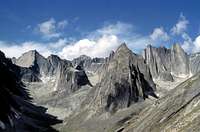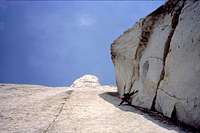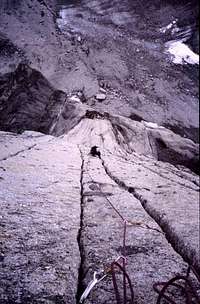|
|
Route |
|---|---|
|
|
61.37896°N / 127.06306°W |
|
|
Big Wall |
|
|
Summer |
|
|
One to two days |
|
|
5.10d (YDS) |
|
|
19 |
|
|
V |
|
|
The Approach
Almost everyone who stays in the Cirque of the Unclimbables camps in Fairy Meadows – this especially makes sense now, as a toilet has been installed here in order to limit human impact on this fragile ecosystem.
The hike from Fairy Meadows to the base of the Lotus Flower Tower (LFT) takes about 45-60 minutes – the last 15 minutes or so, you are on ice (there is lots of rocks and debris on top of the ice, so sometimes it’s hard to tell you are on ice).
Route Description
The start of the LFT is extremely obvious – it is a large left facing corner system capped by a roof. From the bottom of the route – you truly understand why the word “tower” is in the name. It is very daunting to start at the bottom and realize its 2500 feet to the top.
Pitches 1-3 – The first three pitches follow the obvious left corner system until you can move right and over the obvious roof at the end of pitch 3. The first pitch is 5.8, while the second and third pitches are 5.9 and 5.10a respectively. Often these first three pitches are wet making them very difficult (if not impossible to climb free). Many folks who find these pitches wet, aid through the wet sections – it’s only these pitches that take a while to dry out.
We found these first three pitches quite stiff – especially the second pitch, which was essentially a very steep flaring hand jam. The third pitch (rated 5.10a) didn’t seem that bad – we’re probably better at roofs than flaring cracks.
Pitch 4 – Once over the roof, you trend up and slightly right for one pitch aiming for the very obvious chimney system – this is steep 5.7 climbing.
Pitches 5 to 10 – These pitches all climb up the big grubby chimney system and go at 5.7 except for the last pitch, which is 5.8. The climbing is steep with loose rock that you need to be careful about. There are no fixed belays here, so we just climbed until we were more or less out of rope (or gear). When we climbed it, we came about 15 metres short of the bivy ledge at the top of pitch 10, and just simu-climbed this short section so we didn’t have to set up another belay. If you plan to climb the LFT in a day, anything you can do to reduce the number of pitches you have to belay, will speed up your time (hint – make sure you use at least a 60 metre rope).
The Bivy Ledge – This truly is the Cadillac of bivy ledges – it’s about 10' by 10' and totally flat (at one time it had grass on it, but due to heavy traffic, this has long since gone). If you are going to do the route in two days – this is your home for the night. Make yourself comfortable and try not to freeze – if the night is calm and warm, it’s supposed to be somewhat of a spiritual experience.
The Headwall – This is why you came here. Your first view of the white headwall from the bivy ledge is awe inspiring. I don’t think there is another line anywhere like this in the world – a system of cracks goes from the bivy ledge 1000 feet unbroken to the summit. It is also here that you see for the first time the sea of “chicken heads” that protrude from the headwall like holds on a climbing wall. These black protrusions are harder than the surrounding granite and therefore haven’t weathered to the same degree – the result is the multitude of “chicken-heads” you see. Not only do they look cool, but they’ll be your best friend as you ascend the wall.
Pitch 11 – This is the first pitch off the bivy ledge and climbs the VERY obvious huge left facing corner. It’s rate 5.9+ and is a very fun – it will test your stemming skills. You belay at a fixed anchor at the right margin of the headwall.
Pitch 12 – This pitch is probably one of the most photographed and famous moderate alpine pitches anywhere. It’s also on this pitch that you make your only route finding decision of the whole climb – you need to traverse left into the parallel cracks. Make sure you manage your rope drag. The pitch is rated 5.9+ – but is mainly a face climb with the cracks there to provide bomber protection.
Pitch 13 – What can I say – another stellar fun pitch. Keep following the cracks and try not to waste too much energy smiling- yep, it’s that good. The pitch is rated 5.9.
Pitch 14 – More of the same, but a bit easier (5.8) – belay just below the small roof.
Pitch 15 – Another fun moderate pitch with a small roof at the beginning that constitutes the 5.8 crux. You belay about 15 metres below the large roof that splits the headwall.
Pitch 16 – This is the crux pitch, and it’s pretty hard (5.10+). We didn’t find the roof particularly hard (although it’s a lot harder with a pack on), but the thin dirty crack system above the roof, was pretty challenging. If you have any difficulty, it very easy to “French free” the harder portions of this pitch (i.e. pull on a few pieces of gear).
Pitch 17 – In my opinion (and others), this is best pitch on the whole route. It starts with a steep section (about 10 metres) of fist and hand jamming (5.9) with no chicken heads to help you out. Once you pass this section – it’s a stunning climb up a parallel crack system with almost the entire 2500 feet of the route below your feet. The exposure is breath-taking.
Pitch 18 – This pitch is a wider crack (off-width) rated 5.8. Once the leader moves about 15 metres up, the belayer can’t see him/her anymore. It’s prudent to make sure you have worked out some type of signal system so that the belayer will know when the leader is off belay or simu-climbing – it is very likely that you will not be able to hear the leader once they run out of rope. When we climbed this pitch, we simu-climbed the last 15 metres or so to avoid having to set up another belay.
The Summit – It’s a fairly unremarkable flat summit, but it still feels awesome to reach it. You can see all the way down to Glacier Lake – the drop off point for most parties climbing in the Cirque and get a unique view of Mount Proboscis to the south.
Getting Down
As you are climbing up the headwall, take note of the rappel anchors – you rappel the route back down to the bivy ledge. Take care not to snag your rope rapping pitch 18 (the second rappel from the summit). This is the offwidth pitch and there are many ropes visible in the back of this crack – ample evidence of the number of people who have had to cut their rope. Make sure you give your rope a good tug and in the right direction (i.e. away from the crack). We had no issues, but there was much trepidation when we pulled the rope. There is also a snagging hazard rappelling pitch 12, as the rope is falling diagonally and can catch on the chicken-heads.
Once back at the bivy ledge, there is a bolted rappel line right (NE or climbers right) of the chimneys for pitches 4-10. It leaves the NE end of the bivy ledge and goes all the way to the top of pitch 3. You can also rap from the top of pitch 3 to the top of pitch 1 with 60 metre ropes.
Essential Gear and Topos
Standard rack to #4 Friend.
This link contains the standard topo for the Lotus Flower Tower.
This link contains some beta for doing the LFT faster – it’s quite helpful; read it if you are planning to do the route in one day.
Some Additional Hints
Weather - The weather in the Cirque is notoriously bad – many parties try the LFT more than once before the weather cooperates all the way to the top. Lightning storms can occur in the afternoon and evening – the other party we were climbing with was caught in a huge lightning/hail storm on their descent, which left them scared shitless and happy to be alive (a good deal of liquor was consumed that evening, once safely in basecamp). If you do have to climb the LFT more than once – consider leaving the first three pitches fixed. However, depending on how fast you jumar, it might only save you a half hour, as it’s a bit of an ugly jug – a lot of it being free hanging.
One Day or Two - If I was to make a recommendation about whether to do the climb in one day or two – I would most definitely say do it in one day if you can (remember the days here in the summer are very long). The main reason is the weather – having a two day window of good weather is a lot rarer than a one day window.
Photos - Take lots of pictures – it’s a once in a lifetime experience, and it’s almost impossible to take a bad photo on the headwall. Make sure both the leader and belayer have a camera – some of the best pictures are taken looking down the headwall at the follower.
LFT Line ups - Almost everyone in the Cirque is there to climb the LFT as their main objective – when there’s a weather window it might be crowded; do your best to get there first and to be fast.
Trip Report - Here's a trip report from the LFT - Bombing in the Cirque of the Unclimbables












